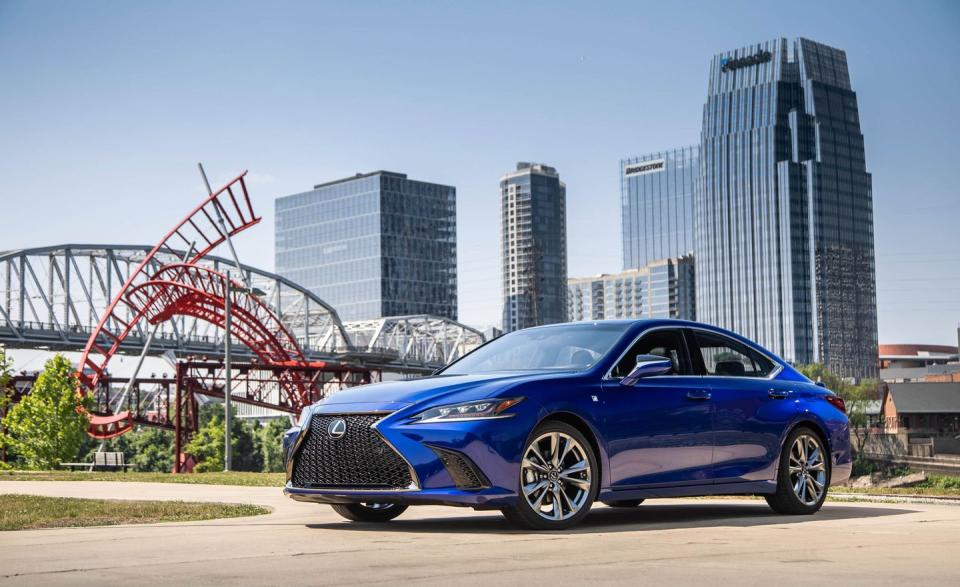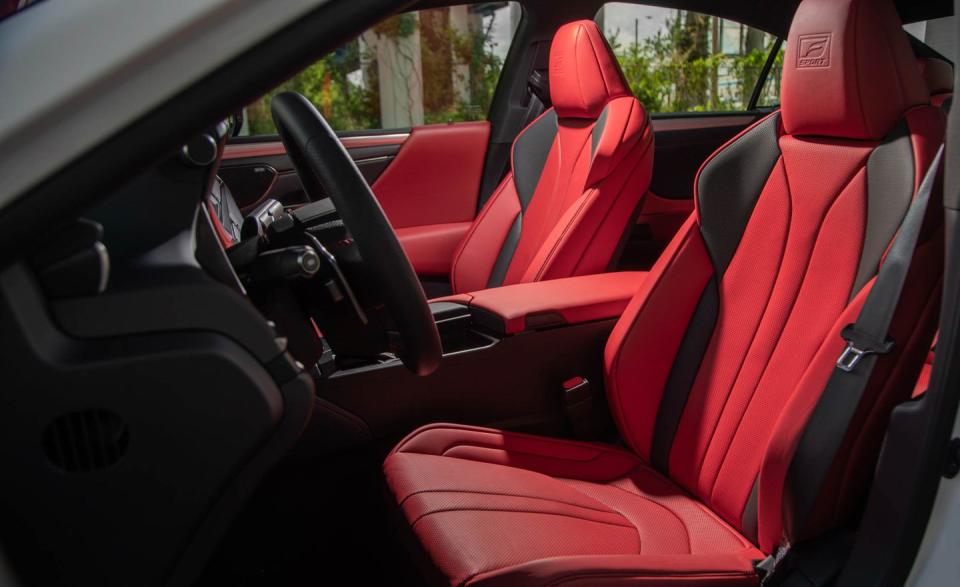2019 Lexus ES Driven: Approaching a Third Decade of Luxury

ES (for Elegant Sedan) is a model designation that dates to 1989, when the ES250 arrived as a 1990 model in a supporting role for the original flagship Lexus LS400. Then, and through its first five generations, the Lexus ES was a version of the Toyota Camry, dressier but equally bland to drive. The direct Camry connection ended with the sixth-gen model, when the ES transferred to the underpinnings of the Toyota Avalon, a change that upgraded its luxury credentials but did little to add dash to its persona.
Now we have-or will have, come October-generation seven. It rides on a variation (GA-K) of the Toyota New Global Architecture (TNGA), which also supports the new Camry and Avalon. It’s 2.6 inches longer than the outgoing car and has a 2.0-inch-longer wheelbase; it’s also a smidge lower and 1.7 inches wider. The revised proportions radiate a sense of power and purpose, and the ES’s first ever sporty F Sport variant is available to deliver on the dynamic promise of the swoopy sheetmetal.
The now familiar spindle grille is bigger, too. Whether this is a plus is up to you, although market research has obviously encouraged the design team to persist with this polarizing feature.
Glue Galore
Citing a vast rope of structural adhesive, plenty of laser screw welding, and increased use of high-strength steel, the Lexus engineering team touts body-shell rigidity as one of several bragging points for this new model. The improvements add up to a modest 6 percent gain overall, although the engineers say this is a little misleading, in that the stiffening measures affect critical elements of the chassis-suspension pickup points, for example-more than others. It also adds up to a slight gain at the scales; how much will vary with equipment, but Lexus cites a general increase of 78 pounds for the ES350.
The slight rise in mass is more than offset by a substantial bump in output from the standard 3.5-liter V-6 that powers the ES350. Displacement is unchanged from the previous generation, but now fed by a combined port- and direct-injection system, the aluminum six gains 34 horsepower and 19 lb-ft of torque for totals of 302 horsepower and 267 lb-ft. And it does so burning regular gasoline.

A new eight-speed automatic replaces the previous six-speed, and the net gain is more hustle when the light turns green-6.6 seconds to 60 mph, according to Lexus, or a half-second quicker than the company’s claim for the 2018 model. Judging by a day of driving rural byways south of Nashville, we have no reason to doubt this forecast. It’s likely to be proved conservative, considering that the previous model did it in 5.8 seconds in our testing, even though responses to the paddle-shift transmission are leisurely.
As with the previous generation, there’s also a gasoline-electric hybrid, dubbed ES300h. It uses a typical Toyota system composed of a new, narrower-bore and longer-stroke 176-hp 2.5-liter inline-four augmented by a 118-hp electric motor for propulsion (a second motor manages the stop/start system and regulates the operation of the continuously variable automatic transmission). The combined system output of 215 horsepower is a 15-hp improvement over the 2018 model. As in the past, Lexus favors a nickel-metal-hydride battery over lithium-ion, and the brand clearly believes the aim of a hybrid is improved fuel economy and not additional performance. A revised and more compact CVT, equipped with paddles to deliver programmed shift points, sends power to the front wheels. Lexus says this combination should run from zero to 60 mph in the same time as the outgoing model (we measured 7.8 seconds for that one). But Lexus’ fuel-economy estimates are impressive: 44 mpg city, 45 highway, and 44 combined, improvements of 4 mpg on the city and combined figures, and a 6-mpg improvement on the highway, where few hybrids excel.
As a driving experience, the hybrid may represent an incremental improvement over the preceding generation. But it’s very much in the relaxed tradition of previous ES sedans. The objective is quiet comfort, and the new car delivers on both counts, particularly hushed operation. While quiet interiors have been a Lexus virtue since the beginning, this car is a library at midnight.
Split personality
In a dynamic sense the ES300h and ES350 represent business as usual, allowing substantial body motions and what’s-your-hurry handling in exchange for maximized comfort. This would be okay if Lexus was content to continue courting the same sort of buyers as the previous six generations. However, the charter for the seventh generation included a corporate mandate to give the ES more emotion, to make it a car that would be not only more exciting to look at but more exciting to drive, according to Lexus. Enter the F Sport.
Although its powertrain is the same as that of the standard ES350, the F Sport feels much more the athlete, thanks primarily to suspension tuning, highlighted by adaptive dampers.
Developed by KYB, the new Adaptive Variable Suspension employs damping that responds rapidly to changing road surface conditions based on multiple presets, and it’s most noticeable in the Sport and Sport+ driving modes. The action is an adaptation of conventional shock technology, with a new internal valving system. The upshot is an ES sedan with level cornering attitudes, eager responses, and precise, tactile steering, augmented by 19-inch wheels fitted with available summer performance tires. It adds up to the first ES that can claim to be a sports sedan with somewhat of a straight face.
Steering Philosophy
The F Sport’s steering is a particularly interesting element of the ES story. Like almost every new car, the rack-and-pinion system of the ES is electrically assisted, and in the redesign the motor moves from the steering column to the rack. Although a little more expensive to engineer and produce, this is an arrangement that usually delivers a more accurate system with a more pronounced sense of tactility. That’s definitely true of the F Sport, but not of the other versions-especially not the ES300h. Lexus engineers say they electronically tuned the system in non–F Sport models to reduce effort and feel, so as to be more appropriate for luxury customers.
Apparently, the perception that trickled down from market research is that the luxury buyers aren’t happy with sporty steering. We wonder if the clinics included owners of any European brands. Be that as it may, the F Sport is clearly an ES game-changer. The sporty spirit extends to the interior, which is as posh as the other members of the clan, with the addition of nicely bolstered front bucket seats-available in snappy red leather that is heated and ventilated-that would be right at home in an Audi.
Luxury abounds in the cabin throughout the line, with tasteful decors and first-rate materials. The ES features list includes an attractively legible TFT instrument cluster, a driver-programmable head-up display (optional), a central infotainment screen atop the dash (measuring 8.0 inches standard, with a 12.3-inch screen optional) that’s easy to read with minimal eye redirection, onboard Wi-Fi, Android Auto and Apple CarPlay compatibility, Siri Eyes Free and Amazon Alexa integration, a premium audio system, and of course a lengthy list of standard passive-safety features.
With the on-sale date still some four or five months away, pricing for the new ES is yet to be announced. Lexus would say only that it will be similar to the current price ladder, which starts just shy of $40,000-with the new addition of the F Sport trim at the high end. Lexus anticipates that that athletic newcomer will account for about 20 percent of ES sales. Based on our first experience, we think this may be very conservative. The new ES is the most elegant execution yet of Lexus’s best-selling sedan. But if elegance is appealing, elegance with pace is more so.
You Might Also Like

 Yahoo Autos
Yahoo Autos 



